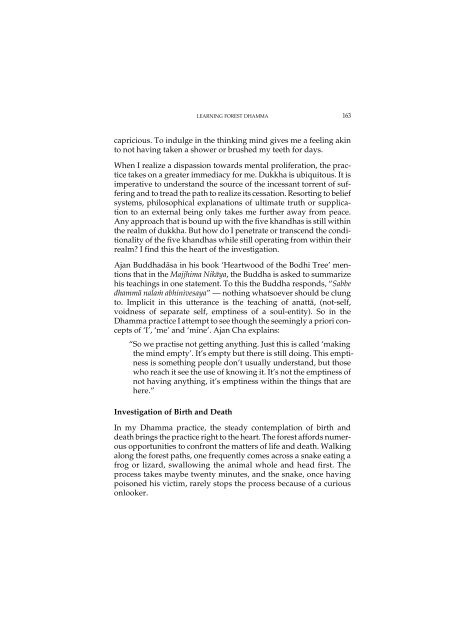Forest Path - Amaravati Buddhist Monastery
Forest Path - Amaravati Buddhist Monastery
Forest Path - Amaravati Buddhist Monastery
Create successful ePaper yourself
Turn your PDF publications into a flip-book with our unique Google optimized e-Paper software.
learning forest dhamma 163<br />
capricious. To indulge in the thinking mind gives me a feeling akin<br />
to not having taken a shower or brushed my teeth for days.<br />
When I realize a dispassion towards mental proliferation, the practice<br />
takes on a greater immediacy for me. Dukkha is ubiquitous. It is<br />
imperative to understand the source of the incessant torrent of suffering<br />
and to tread the path to realize its cessation. Resorting to belief<br />
systems, philosophical explanations of ultimate truth or supplication<br />
to an external being only takes me further away from peace.<br />
Any approach that is bound up with the five khandhas is still within<br />
the realm of dukkha. But how do I penetrate or transcend the conditionality<br />
of the five khandhas while still operating from within their<br />
realm? I find this the heart of the investigation.<br />
Ajan Buddhadàsa in his book ‘Heartwood of the Bodhi Tree’ mentions<br />
that in the Majjhima Nikàya, the Buddha is asked to summarize<br />
his teachings in one statement. To this the Buddha responds, “Sabbe<br />
dhammà nalaÿ abhinivesaya” — nothing whatsoever should be clung<br />
to. Implicit in this utterance is the teaching of anattà, (not-self,<br />
voidness of separate self, emptiness of a soul-entity). So in the<br />
Dhamma practice I attempt to see though the seemingly a priori concepts<br />
of ‘I’, ‘me’ and ‘mine’. Ajan Cha explains:<br />
“So we practise not getting anything. Just this is called ‘making<br />
the mind empty’. It’s empty but there is still doing. This emptiness<br />
is something people don’t usually understand, but those<br />
who reach it see the use of knowing it. It’s not the emptiness of<br />
not having anything, it’s emptiness within the things that are<br />
here.”<br />
Investigation of Birth and Death<br />
In my Dhamma practice, the steady contemplation of birth and<br />
death brings the practice right to the heart. The forest affords numerous<br />
opportunities to confront the matters of life and death. Walking<br />
along the forest paths, one frequently comes across a snake eating a<br />
frog or lizard, swallowing the animal whole and head first. The<br />
process takes maybe twenty minutes, and the snake, once having<br />
poisoned his victim, rarely stops the process because of a curious<br />
onlooker.

















